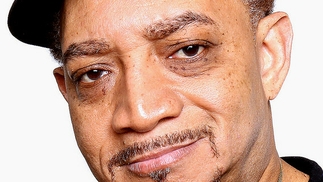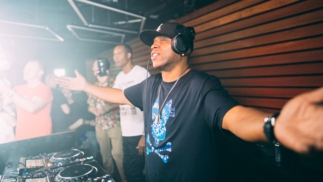Kerri Chandler: "I’ve never tried to copy anyone’s style, never tried to be anyone else but me"

DJ Mag spends an evening with veteran house producer and maverick DJ Kerri Chandler. The force behind labels Madhouse, MadTech and Kaoz Theory’s home studio is bursting with music tools fit for an audiophile king. After a three-decade career producing instant classics for the dancefloor and touring the world he shows no sign of slowing down...
The lower floor of Kerri Chandler’s house looks like the backstage production labyrinth of a massive arena. Hallway after hallway, shelf after shelf, room after room, there are stacks of music gear, flight cases, records, records and then some more records. Plus 36 sets of turntables, a drum machine closet and enough technology to fulfill any audiophile’s dreams. He has a live recording room and another room for programming, set up with numerous screens like a multiplex theatre. The hope is that the longstanding DJ/producer and genuine house music legend never has to move because that would be ugly and super stressful.
Everything in view—and not in view—doesn’t belong to Chandler alone. His musically-inclined 21-year-old daughter has stamped her presence in many of these spaces, albeit a very different one from her father’s as she favors obscure psychedelic sounds from the ’60s and the groovy ones of the ‘70s. His 14-year-old son hasn’t taken over this area, even with his affinity for Korg gear. He has his own workstation upstairs where he and his friends spend their time hacking and coding, modifying video games. Then there are the mountains of gear that belonged to Chandler’s father, now passed, but never forgotten, and clearly living on in his descendants’ genetics.
It is from his offspring that Chandler receives his motivation. Pictures of them sit in his eyeline, a gentle reminder of what it is all about. And it is from Chandler Senior that they in turn inherited his love of DJing, his extensive knowledge about music, particularly the homegrown ones of his native New York and New Jersey, and his instinctual understanding and deftness with technology. The now common term “Chandlerization” was coined for equipment that has been tweaked either by Chandler himself, or under his direction, invariably making it better, more effective, and more flexible with its capabilities.

“What happened was,” says Chandler, who begins all his stories and/or explanations with these three words. “What happened was, I was a studio engineer before I ever started making records. Early on, I found out a lot of gear wasn’t doing certain things I wanted it to do,” Chandler explains to DJ Mag how “Chandlerizing” became a thing. “For instance, I asked Studio Electronics if they could put a MIDI kit into my 808, and they did, but the clap and cowbell were in the same key, which was their mistake. They talked me through opening it, changing the resisters, and I realized all the resistance changed, which made me think, ‘What else can I do with this’? After that I started changing everything.”
For many years Kerri Chandler has been working with professional audio manufacturers, Native Instruments and Roland among them, coming up with improvements on existing items and breakthroughs on new ones. One of the companies he is working with at the moment is Dolby and their Atmos immersive sound system for the club environment. The first show Chandler did using Atmos was at Ministry of Sound in spring of 2016. The second system has been installed at Halcyon in San Francisco. The plan is to have it in 12 clubs worldwide by the year’s end.
“It’s beyond surround sound,” Chandler explains. “You can hear everything everywhere in the room and you can control it almost 360°. I can take a snare drum and run it around the room, make it go behind me and come back up and have it sound like it’s all around you. Atmos is one of many space-based elements in Chandler’s life, a conscious occurrence on his part as his fascination with the cosmos is an ongoing one. He takes out a replica of The Golden Record sent up in the Voyager 1 spacecraft in 1977. The original functions as a time capsule of sorts with drawings on the cover that show how the record is to be played.

On it are sounds from Earth: nature, animals, music from across the globe, and a variety of languages.
“I was thinking maybe we should put something positive into space,” says Chandler, fondling the cherished Golden Record replica. “Music is always universal. What we do always seems to unite people. I met someone who works with Messaging Extraterrestrial Intelligence and we found a planet to send audio signals to. We got sponsorship and now there are a few DJs with 8-bit clips ready to send out to that galaxy to hit that planet.”
This will be Chandler’s second message sent into outer space. Sphere-centric from the start, among his sphere-named releases are the ‘Atmosphere’ EP, and ‘Trionisphere’ and ‘Hemisphere’ albums, to mention a few. One of his most beloved tracks, ‘Track 1’ from the ‘Atmosphere’ EP released in 1993, is what he chose as his message to outer space which was transmitted, quite appropriately, from the Sonar
Festival in Barcelona last June, some 40 years after Voyager 1. Chandler’s momentous missive to the world this summer is a little closer to home. His Madhouse records—the longest running of his three active labels—turns 25 this year. To commemorate the occasion, Chandler is attempting to put together a compilation, but it’s proving challenging, certainly time-wise, as even the approach to this not-yet-formulated release is difficult to determine.
“I haven’t put my finger on it yet,” concedes Chandler about what exactly he wants this compilation to encompass. “A combination of new and old stuff. I’m going back through the entire catalog, trying to pick out things that aren’t as well-known, but then there are alternate versions of things, and how to combine them all together with the newer guys and make it all come together in a nice balance.”

At the same time, Chandler is working on the third volume of ‘A Basement, A Red Light, And A Feelin’’, the Madhouse compilation series whose first volume was released in 1992, the second 10 years later in 2002. A third one would be another marker for the quarter century landmark. Much more recently Chandler launched his MadTech label in 2012 and even more recently than that, Kaoz Theory, named after his oft-used nickname “Kaoz”, in 2015. The former was started because of all the young, fresh talent Chandler was meeting, particularly during his residency at Ibiza’s DC-10 over the last eight years.
He wanted to create a platform for newer artists to establish a fanbase and a springboard from which they could launch themselves. The latter was started as an outlet for Chandler’s dubs, tracks made in a harder style, similar to what he plays at DC-10, which is a sharp contrast to the soulful vocal house for which Madhouse is known. It has also featured releases from his DC-10 compatriots Jamie Jones,
Seth Troxler, and the Martinez Brothers. “The quality at DC-10 is high,” states Chandler who knows a thing or two about DJing, having spun his first official set at the Rally Record Club in East Orange, NJ at the age of 13. “Before it was like you were getting meat, potatoes and a side of veggies. Now all you’re getting is meat, straight meat. When you go in there, you’ve got to have your ideas together, you’ve got to have your palette straight. You don’t mess about in that place because everyone is giving their all.”
He continues, “I’ve been inspired over the last year. With all the traveling and meeting new people like Peggy Gou and hearing what they did to some of my tracks that I really enjoy, and hanging out with old friends like Voyeur has been really cool. Now I’m back in the studio and I feel I have something to express. I don’t want to repeat myself. If I don’t have anything to say, then I’m not going to force myself, but I’m inspired.”
Chandler’s release output is consistent, and his popularity is on a permanent upward swing. “A lot of kids went back and found stuff I did on YouTube,” he says, speaking of remaining relevant. “I’ve always stayed true to what I felt. I’ve never tried to copy anyone’s style, never tried to be anyone else but me, just the best me I can be. I’ve never had a timeframe that has been my favorite. I’m still looking for that. And I’ve always stayed curious. I have a lot of fun. I listen a lot. I don’t act like I know everything, because I don’t. And I make a lot of friends.”
Chandler is as professional as he is friendly. His incredibly professional attitude toward DJing has been in place long before the electronic dance music industry caught up to him. In terms of all-encompassing professionalism, he still is a number of steps ahead of his peers, drawing from his family’s sound engineering background to fine-tune any space to its maximum aural capabilities. To this end, he arrives early for a soundcheck that involves all parts of space from updating DJ equipment software to replacing physical parts of the set-up to adjusting the sonics.

“When you’re a resident in New York, you have to do everything,” he says referring to when he cut his teeth at the city’s clubs. “It wasn’t some kind of fad. You have to know lights. You have to know sound. You have to know gear. You have to know how to DJ. I keep up that same quality of what we had in clubs when I was younger. The people that are coming up after me, I show them how to do a lot of the stuff I do. I have no problems passing things on. It was passed off to me by Francois Kevorkian and David Mancuso and Larry Levan.”
Hands-on is how Chandler started and how he continues to work. While everyone keeps things “in the box,” Chandler keeps adding to his tactile collection stating he could never get used to the laptop-and-controller combination—but he still has a couple of bass guitars, one of his foundation instruments to this day. “I do rough sketches on the laptop when I’m on the road, but when I get back to the studio, I just start again from scratch,” explains Chandler who has never completed a song on a laptop. “Nobody gives a crap where it comes from, they just want to dance to it. I like touching physical things. That’s also why all my screens are touchscreen, so I can move the fader with my finger rather than a mouse. Even my mouse is a trackball. That’s just how it is for me.”
There is the danger of new equipment getting absorbed into Chandler’s warren of instruments. When he gets his hands on something new, he doesn’t immediately set it up in his studio. He keeps it upstairs, most often in his kitchen, where he listens to the machine’s sounds through its jack, on headphones, learning every single one before he incorporates it into his collection. This was the case with one of his recent acquisitions, Roland’s TR-8, which of course he Chandlerized with updates so the drum machine not only has the sounds of the classic 808 but also the 909 and 707 on it.

In addition to the standard DJ gear, Chandler totes around a keyboard to his gigs, more things with which to physically interact. He has been playing the piano since he was nine years old, this is on top of the stand-up bass, and adding its sounds to his DJ sets is instinctual. He remembers the songs his father used to play and from that is where he decides where to add a segue or some piano lines on top of the record he’s playing. “I’m so used to having a keyboard in front of me, it’s kind of like having a studio setting to enhance what I do,” he says. “The more it looks like a studio and feels like a studio, the more I can create in any environment. It’s kind of like my second voice.”
He adds, “If I ever feel like I don’t enjoy it as much as I did the first time I put a record on a turntable, I need to stop. The only time I’ve ever slowed down was to watch my kids being born and spending time with them when they were babies. I didn’t want to miss anything. When they understood what I was doing, I went right back to it.
This is the ethos that translates to everyone who comes in contact with Kerri Chandler—from the home to the club. “That’s how I treat people and how I want it to happen for people.” Quoting his own signature words, he reminds us of his message: “Love, respect and admiration.”







